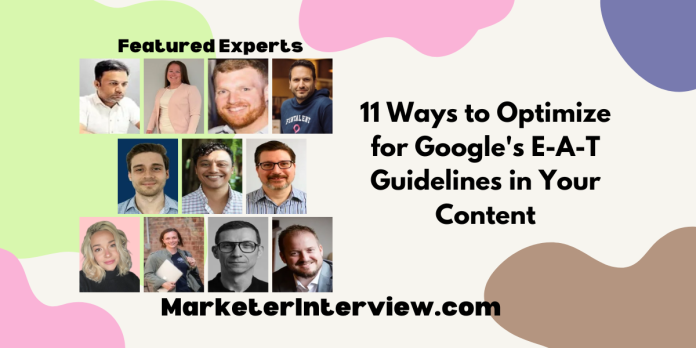How to Optimize for Google’s E-A-T Guidelines
When it comes to search engine optimization (SEO), the goal is not just to drive traffic but to drive quality traffic—users who find your content valuable, informative, and trustworthy. This is where Google’s E-A-T guidelines come into play.
E-A-T stands for Expertise, Authoritativeness, and Trustworthiness, and it plays a pivotal role in determining how well your website ranks on Google. In this article, we will break down what E-A-T SEO is, why it matters, and how you can optimize your website to align with Google’s guidelines to boost your SEO trustworthiness and ultimately improve your search rankings.
1. What Is E-A-T and Why Does It Matter for SEO optimization?
Google’s E-A-T guidelines are part of their broader set of quality rater guidelines. They were introduced to help Google’s human quality raters evaluate the quality of search results. While Google doesn’t directly use E-A-T as a ranking factor, it certainly influences how Google’s algorithms assess the value and relevance of web pages.
Expertise: Google wants to rank content that is produced by individuals who have a high level of expertise in their field. For example, a medical article should be written by a healthcare professional, or a financial article should come from someone with knowledge of finance.
Authoritativeness: This refers to the reputation of the website or author. A well-known brand or expert in a particular field is more likely to be trusted and deemed authoritative. In other words, the website needs to have a proven track record of providing high-quality, reliable content.
Trustworthiness: This focuses on the reliability and credibility of both the content and the website itself. Google favors sites that have clear, transparent policies (such as privacy and security), a secure browsing experience (HTTPS), and trustworthy references.
Optimizing your content to align with these three principles is critical if you want to rank higher and gain trust from both Google and your audience.
2. How to Improve Your E-A-T for SEOa. Establish Author Expertise
One of the first steps in optimizing for E-A-T SEO is to establish the expertise of the content creators. Google places a high value on content written by experts in the field, so ensuring that your website has clear, credible author bios is key.
- Author Bio Pages: Include detailed author bios that highlight their credentials, experience, and qualifications. For instance, a blog post about health or medical topics should feature the author’s medical background and certifications.
- Guest Contributions from Experts: If your content team doesn’t consist of subject-matter experts, consider collaborating with industry professionals or guest writers who can bring authority to your content.
b. Build Authoritativeness Through High-Quality Content and Backlinks
Building authoritativeness is all about creating valuable content that resonates with your audience and earning links from high-quality websites. These backlinks act as “votes of confidence” in your website’s authority.
- Create High-Quality, In-Depth Content: Google rewards content that is comprehensive, well-researched, and provides real value to readers. In-depth guides, case studies, and research-backed articles are great ways to establish authority in your niche.
- Earn Backlinks: Focus on earning backlinks from authoritative sites in your industry. The more respected websites that link to your content, the more authoritative your site will appear to Google. This can be done through content outreach, guest blogging, and PR campaigns.
c. Maintain Transparency and Trustworthiness
To improve trustworthiness, your website needs to be transparent, secure, and user-friendly. Google evaluates trustworthiness based on several factors, such as your website’s security and clear privacy policies.
- Secure Website (HTTPS): Make sure your site is using HTTPS encryption to ensure user data is secure. Google gives a ranking boost to secure websites, and users are more likely to trust a site that keeps their information safe.
- Clear Privacy Policies and Contact Information: Transparency is crucial. Make sure your website clearly displays your privacy policies, terms of service, and contact information. Websites with robust contact information (such as a physical address or customer service line) are deemed more trustworthy by Google.
- User Reviews and Testimonials: Incorporating user reviews and testimonials into your content can help build trust with both Google and your audience. Positive reviews from users help reinforce your website’s credibility and encourage new visitors to engage with your content.
d. Cite Authoritative Sources
Google values content that is backed by credible, authoritative sources. This means that whenever possible, you should reference well-known studies, journals, and experts in your industry.
- Link to Reputable Sources: Whenever you use statistics, studies, or research, link to the original sources. Citing reputable websites, academic journals, or government publications can significantly boost your trustworthiness in Google’s eyes.
- Avoid Misinformation: Ensure that the information provided is accurate and fact-checked. Misinformation not only harms your reputation but can lead to penalties from Google.
e. Enhance User Experience (UX)
Google doesn’t just look at content quality; it also cares about the user experience (UX). A seamless UX is indicative of a trustworthy and professional website, which directly impacts your E-A-T score.
- Improve Site Speed: A fast-loading site is essential for both user experience and SEO. Slow websites have higher bounce rates, which can negatively affect your rankings. Use tools like Google PageSpeed Insights to analyze and optimize your website’s speed.
- Mobile-Friendliness: Make sure your site is mobile-responsive. With an increasing number of users accessing websites from mobile devices, Google ranks mobile-friendly websites higher.
- Clear Navigation and Design: Ensure your website is easy to navigate and aesthetically pleasing. A confusing layout or cluttered design can drive visitors away, impacting your trustworthiness.
3. Conclusion: Aligning with Google’s E-A-T Guidelines for SEO Success
E-A-T SEO optimization is a crucial part of your website’s ranking potential. By focusing on expertise, authoritativeness, and trustworthiness, you can significantly enhance your site’s credibility with both Google and your visitors. The benefits of optimizing for Google’s E-A-T guidelines extend beyond just improved rankings—they also help foster a positive user experience, encourage engagement, and build long-term trust.
To get started, review your website’s content and structure. Ensure that your authors are qualified, your sources are credible, and your user experience is top-notch. By applying these principles, you’ll not only meet Google’s guidelines but also create a website that your audience trusts and returns to.
Ready to improve your E-A-T SEO? If you are working on seo optimization of the website for windscreens, Start with these strategies today and see the impact on your rankings and traffic!



